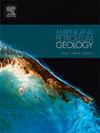下刚果盆地在塞诺曼-土伦阶段的沉积特征:细粒沉积岩的启示
IF 3.6
2区 地球科学
Q1 GEOSCIENCES, MULTIDISCIPLINARY
引用次数: 0
摘要
以大面积黑色页岩和大洋缺氧事件 2(OAE 2)为标志的仙人掌-震旦纪(C-T)阶段,对于解读古海洋学条件和碳氢化合物形成的主要驱动因素至关重要。尽管西非中部的下刚果盆地(LCB)蕴藏着巨大的石油和天然气潜力,但对其研究严重不足,尤其是在 C-T 阶段(利夸拉地层),这主要是由于勘探有限以及历史上对其他盆地的偏好。因此,了解 LCB C-T 阶段的沉积特征对于阐明古海洋学条件、评估油气潜力和解释环境变化至关重要。由于已公布的数据和样本有限,我们采用了有针对性的综合地质分析来获得全面的认识,包括测井、岩相识别、薄片观察、粒度测量和地球化学分析(主要元素、痕量元素和稀土元素),以提供具有凝聚力和确认性的评估。利用相对海平面曲线和地球化学指标,并与其他相关盆地进行比较,本研究初步确定了 OAE 2 地层区间,并试图讨论 OAE 2 对 LCB 有机质富集的影响。研究结果表明,在 C-T 阶段,LCB 的海湾环境受到限制,陆地输入有限,水体缺氧。多种地球化学代用指标表明,相对海平面的变化极大地影响了古生产率,从而影响了有机质的富集。在下利夸拉地层(LLF)沉积时期,海平面相对下降导致边缘受限海湾环境的弱还原条件,从而导致初级生产力低下。相反,在上利夸拉地层(ULF)沉积期,风化输入增强和海平面上升增加了来自公海的营养供应。这导致表层海洋生产力提高,水柱中的还原条件增强,形成了边缘半限制性海湾环境。然而,边缘限制海湾环境和有限的水交换可能制约了 OAE 2 对古生产率的提高。这些见解不仅大大加深了我们对 C-T 阶段 LCB 中富含有机质的细粒沉积岩的理解,而且有助于更广泛地理解南大西洋的古海洋学条件以及 C-T 阶段区域地质过程与全球气候事件之间的相互作用。本文章由计算机程序翻译,如有差异,请以英文原文为准。
Depositional characteristics in the Lower Congo Basin during the Cenomanian-Turonian stage: Insights from fine-grained sedimentary rocks
The Cenomanian-Turonian (C-T) stage, marked by extensive black shales and Oceanic Anoxic Event 2 (OAE 2), is pivotal for deciphering paleoceanographic conditions and the main drivers of hydrocarbon formation. Despite its significant oil and gas potential, the Lower Congo Basin (LCB) in central West Africa, particularly during the C-T stage (Likouala Formation), has been severely understudied, primarily due to limited exploration and a historical preference for other basins. Therefore, understanding the depositional characteristics of the C-T stage in the LCB is essential for elucidating paleoceanographic conditions, evaluating hydrocarbon potential and interpreting environmental changes. Due to the limited availability of published data and samples, we employed a targeted and integrated geological analysis to gain comprehensive insights, encompassing logging, lithofacies identification, thin-section observations, grain size measurements, and geochemical analyses (major, trace, and rare earth elements), to provide a cohesive and confirmatory assessment. Utilizing relative sea-level curves and geochemical indicators, and by comparing with other relevant basins, this study preliminarily identified OAE 2 stratigraphic intervals and attempted to discuss the impact of OAE 2 on organic matter enrichment in the LCB. The results indicate that, during the C-T stage, the LCB featured a restricted sea bay environment with limited terrestrial input and anoxic waters. Multiple geochemical proxies suggest that relative sea-level changes significantly affected paleoproductivity, thereby influencing organic matter enrichment. During the depositional period of Lower Likouala Formation (LLF), a relative sea-level drop resulted in weakly reducing conditions in a marginal restricted sea bay environment, leading to low primary productivity. Conversely, during the depositional period of Upper Likouala Formation (ULF), enhanced aeolian input and sea-level rise increased nutrient supply from the open ocean. This led to elevated surface marine productivity and intensified reducing conditions in the water column, forming a marginal semi-restricted sea bay environment. Enhanced reducing conditions within the lower stratigraphic intervals of the ULF are likely consequences of OAE 2. However, the marginal restricted sea bay environment and limited water exchange may have constrained the enhancement of paleoproductivity by OAE 2. These insights not only significantly enhance our understanding of the organic-rich fine-grained sedimentary rocks in the LCB during the C-T stage, but also contribute to a broader comprehension of the South Atlantic's paleoceanographic conditions and the interplay between regional geological processes and global climate events during the C-T stage.
求助全文
通过发布文献求助,成功后即可免费获取论文全文。
去求助
来源期刊

Marine and Petroleum Geology
地学-地球科学综合
CiteScore
8.80
自引率
14.30%
发文量
475
审稿时长
63 days
期刊介绍:
Marine and Petroleum Geology is the pre-eminent international forum for the exchange of multidisciplinary concepts, interpretations and techniques for all concerned with marine and petroleum geology in industry, government and academia. Rapid bimonthly publication allows early communications of papers or short communications to the geoscience community.
Marine and Petroleum Geology is essential reading for geologists, geophysicists and explorationists in industry, government and academia working in the following areas: marine geology; basin analysis and evaluation; organic geochemistry; reserve/resource estimation; seismic stratigraphy; thermal models of basic evolution; sedimentary geology; continental margins; geophysical interpretation; structural geology/tectonics; formation evaluation techniques; well logging.
 求助内容:
求助内容: 应助结果提醒方式:
应助结果提醒方式:


